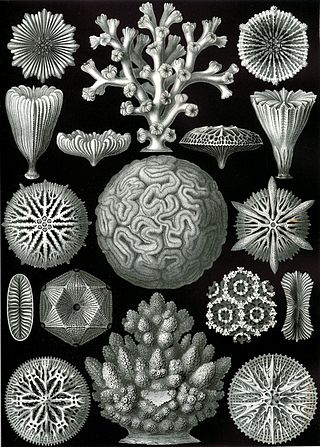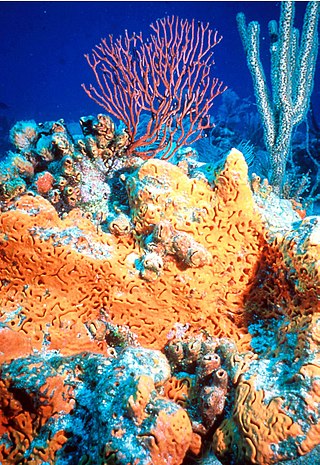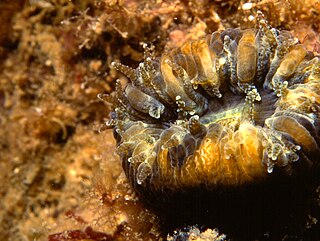
Corals are colonial marine invertebrates within the subphylum Anthozoa of the phylum Cnidaria. They typically form compact colonies of many identical individual polyps. Coral species include the important reef builders that inhabit tropical oceans and secrete calcium carbonate to form a hard skeleton.

Anthozoa is a subphylum of marine invertebrates which includes sessile cnidarians such as the sea anemones, stony corals, soft corals and sea pens. Adult anthozoans are almost all attached to the seabed, while their larvae can disperse as planktons. The basic unit of the adult is the polyp; this consists of a cylindrical column topped by a disc with a central mouth surrounded by tentacles. Sea anemones are mostly solitary, but the majority of corals are colonial, being formed by the budding of new polyps from an original, founding individual. Colonies are strengthened by calcium carbonate and other materials and take various massive, plate-like, bushy or leafy forms.

Scleractinia, also called stony corals or hard corals, are marine animals in the phylum Cnidaria that build themselves a hard skeleton. The individual animals are known as polyps and have a cylindrical body crowned by an oral disc in which a mouth is fringed with tentacles. Although some species are solitary, most are colonial. The founding polyp settles and starts to secrete calcium carbonate to protect its soft body. Solitary corals can be as much as 25 cm (10 in) across but in colonial species the polyps are usually only a few millimetres in diameter. These polyps reproduce asexually by budding, but remain attached to each other, forming a multi-polyp colony of clones with a common skeleton, which may be up to several metres in diameter or height according to species.

Mussidae is a family of stony coral in the order Scleractinia. Following a taxonomic revision in 2012, the family is now restricted to species found in the Atlantic Ocean, with Pacific species transferred to the new family Lobophylliidae. Many species are referred to as brain coral because their generally spheroid form and grooved surface resembles the convolutions of a brain.

Fire corals (Millepora) are a genus of colonial marine organisms that exhibit physical characteristics similar to that of coral. The name coral is somewhat misleading, as fire corals are not true corals but are instead more closely related to Hydra and other hydrozoans, making them hydrocorals. They make up the only genus in the monotypic family Milleporidae.

Sea anemones are a group of predatory marine invertebrates constituting the order Actiniaria. Because of their colourful appearance, they are named after the Anemone, a terrestrial flowering plant. Sea anemones are classified in the phylum Cnidaria, class Anthozoa, subclass Hexacorallia. As cnidarians, sea anemones are related to corals, jellyfish, tube-dwelling anemones, and Hydra. Unlike jellyfish, sea anemones do not have a medusa stage in their life cycle.

Porites astreoides, commonly known as mustard hill coral or yellow porites, is a colonial species of stony coral in the family Poritidae.

Tubastraea, also known as sun coral or sun polyps, is a genus of coral in the phylum Cnidaria. It is a cup coral in the family Dendrophylliidae.

Eusmilia is a genus of stony coral in the family Meandrinidae. It is a monotypic genus represented by the species Eusmilia fastigiata, commonly known as the smooth flower coral. It is found on reefs in the Caribbean Sea.

Balanophyllia bonaespei is a species of solitary cup coral, a stony coral in the family Dendrophylliidae. It is an azooxanthellate species that does not contain symbiotic dinoflagellates in its tissues as most corals do.

Plexaurella nutans, the giant slit-pore sea rod, is a tall species of soft coral in the family Plexauridae. It is a relatively uncommon species and is found in shallow seas in the Caribbean region.

Balanophyllia europaea, called also scarlet coral or pig-tooth coral, is a small species of stony coral in the family Dendrophylliidae.

Leptopsammia pruvoti, the sunset cup coral, is a solitary stony coral in the family Dendrophylliidae. It is an azooxanthellate species, meaning its tissues do not contain the symbiotic unicellular algae (zooxanthellae) of the genus Symbiodinium, as do most corals. It is native to the Mediterranean Sea. The species was described by Henri de Lacaze-Duthiers in 1897 and named to honor the French marine biologist Georges Pruvot.

Astroides is a genus of stony cup corals in the family Dendrophylliidae. It is monotypic and the only species is Astroides calycularis, which is endemic to the western Mediterranean Sea. The species was first described in 1766 by the German naturalist Peter Simon Pallas.

Caryophyllia smithii, the Devonshire cup coral, is a species of solitary coral in the family Caryophylliidae. It is native to the northeastern Atlantic Ocean, the North Sea and the Mediterranean Sea. There are shallow and deep-water forms which are structurally different. It forms part of a biodiverse community of rock encrusting organisms and is often parasitised by a barnacle.

Millepora complanata, commonly known as blade fire coral, is a species of fire coral in the family Milleporidae. It is found in shallow waters in the Caribbean Sea where it is a common species. The International Union for Conservation of Nature has assessed its conservation status as being critically endangered.
Cycloseris curvata is a species of disc coral in the family Fungiidae. Cyclosteris curvata is a mostly solitary free living scleractinian disc coral found in the indo-pacific region. They grow on soft substrates and are known to tolerate turbid waters. Like other anthozoan corals they lack a medusa stage characteristic of other cnidarians. They have been observed as both green and brown in color in the field.

Zancleidae is a family of cnidarians belonging to the order Anthoathecata.
Cladopsammia manuelensis, more commonly known as Sun coral or Cup coral, is an azooxanthellate, "true" coral species, and stony coral species. Cladopsammia manuelensis is present in marine environments only and is home to the deep and shallow waters of the Atlantic and Indian Oceans.
















